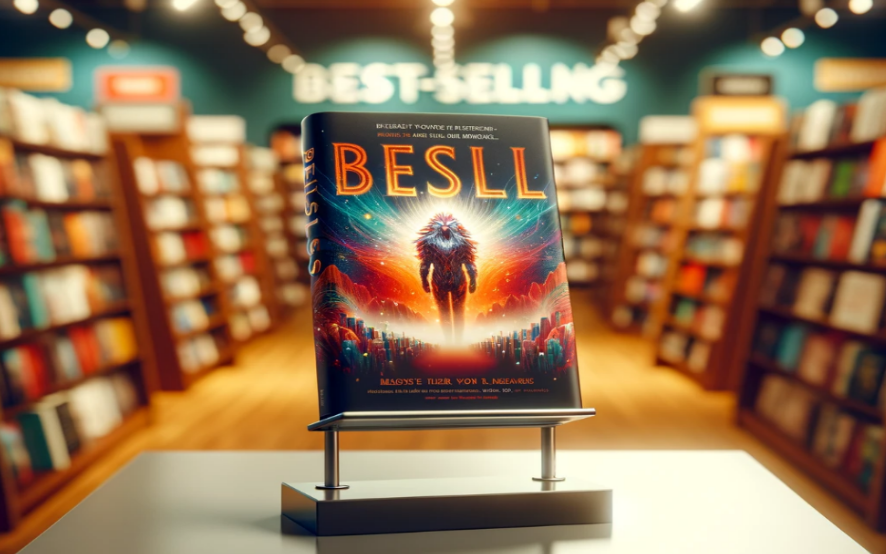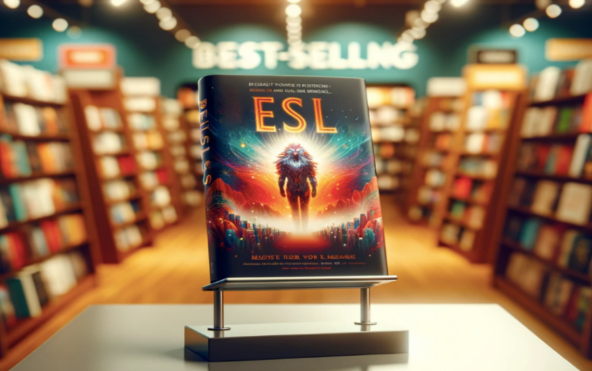Becoming a bestselling author is a dream shared by countless aspiring writers, yet the journey from amateur to bestselling author can be a daunting one. While talent and creativity undoubtedly play their part, the path to literary success is also paved with effective book writing strategies.
In this article, we embark on a journey of exploration, uncovering the essential techniques and insights required to make your dream into a reality. It aims to guide you through the intricate process of writing a book, providing invaluable strategies and practical tips to elevate your writing process. By understanding these critical elements to start writing, and adopting the strategies of successful authors, the road to becoming a bestselling author is at your fingertips.

Creating a Bestseller: The Writing Process
Writing a book is a journey through distinct stages: brainstorming, drafting, revising, editing, and publishing. Each phase is crucial in transforming a concept into a polished book.
In the brainstorming stage, writers unleash creativity, exploring themes and characters without the constraints of structure. This free-flowing creativity is vital for laying the groundwork of the story.
Drafting then gives shape to these ideas, translating them into written form. It’s important here not to aim for perfection but to build a solid foundation for the story.
The revision stage is where the draft is critically examined and refined. Plot intricacies are smoothed out, characters gain depth, and the narrative flow is enhanced. This editing process often requires multiple rounds of adjustments.
Editing focuses on technical aspects like grammar, language, and syntax, polishing the manuscript for clarity and coherence. Professional editors may assist in this phase to provide objective critiques.
The final step, publishing, brings the manuscript to the public, whether through traditional means, self-publishing routes, or innovative AI Publishing platforms.
Start Your Publishing Journey FOR FREEDeveloping Book Writing Strategies
Developing effective strategies for writing books is a complex task that encompasses more than just creating engaging stories. It also involves understanding which techniques work best for you. Adopting a well-rounded approach to book writing strategies can significantly enhance a writer’s skill set.
Writing Strategies:
The first step is understanding the plethora of good writing strategies already available. As explored further below, these include plotting techniques, character development methods, learning from mentors, and regular practice.
Three-Act Structure for Effective Storytelling
This plotting technique involves dividing the narrative into three distinct sections: the setup, the confrontation, and the resolution. It helps in creating a well-paced and engaging storyline, ensuring that the narrative has a clear beginning, middle, and end. This structure is a fundamental guide in building tension and climax effectively.
Character Interviews
Character interviews are a creative method where the writer poses questions to their characters as if they were real people. This technique allows for a clear articulation of characters’ motivations, backgrounds, and personalities more deeply, leading to more nuanced and believable characters in their stories.
Employing Thematic Exploration Tools
Thematic exploration involves delving into the underlying messages or central themes of the story. By using various tools to explore these themes, it will add layers of meaning to your writing, making it more resonant and impactful for the reader. This exploration not only enriches the narrative but also encourages critical thinking about the messages you wish to convey through storytelling.
Learning from Mentor Texts
Mentor texts are published works by skilled authors that serve as learning tools for new writers. By analyzing these texts, you gain insights into the most effective strategies for storytelling, character development, pacing, and stylistic choices. Reading actively, and noting how the author constructs dialogue, builds tension, or develops characters, makes a huge difference. This learning method is particularly effective because it showcases the practical application of writing concepts in successful books.
Regular Writing Practice
Much like any other skill, writing requires regular practice to develop. Consistent writing helps in honing one’s style, improving narrative flow, and building discipline. Daily writing exercises, such as journaling, writing short stories, or even working on different sections of a book, can significantly improve your writing. In order to maintain momentum, it can be beneficial to set specific writing goals, for example, word count targets or completion of specific sections within a time limit.
Start Your Publishing Journey FOR FREEEffective Writing
Structuring your writing is crucial for clarity and impact. It involves more than just the arrangement of thoughts, it’s about creating a framework that enhances your narrative and engages your audience. Here are some ways to help you with this process:
Scripted Writing Programs
A scripted writing program can offer a structured approach, providing templates and guidelines that help shape your narrative. These programs can be particularly beneficial for new writers, offering a clear framework to follow. They break down the writing process into manageable parts, guiding you on aspects like character development, plot progression, and thematic exploration. However, it’s important to use these programs as guides rather than strict templates, ensuring that creativity and personal style are not stifled.
Beginning Your Writing
Starting a writing project can be daunting. One effective strategy is to begin with a clear idea or question that your book seeks to explore or answer. This central concept can then guide the development of characters, setting, and plot. Another strategy is to start with character development, letting the characters’ motivations and conflicts drive the narrative. Some people find it helpful to begin with a detailed outline, while others prefer a more organic approach, letting the story unfold naturally.
Consistency in Writing Style
Developing a consistent writing style is vital. This doesn’t mean each piece of writing must sound the same, but rather that each work should have a distinct, recognizable voice and tone appropriate for the genre and audience. Consistency in style helps in building a connection with readers and enhances the overall reading experience.
Sentence Structure and Word Choice
The power of writing also lies in the nuances of sentence structure and word choice. Varied sentence lengths can affect the rhythm and pace of the narrative, while precise word choice can convey mood, character, and setting more effectively. Paying attention to these details can elevate your writing, making it more vivid and engaging.
Enhancing Creativity and Overcoming Writer’s Block
Creativity is the lifeblood of writing, but even the most imaginative and skilled authors can encounter the dreaded writer’s block. Overcoming this and constantly generating new ideas are crucial skills in a writer’s toolkit.
Techniques for New Ideas: One effective technique for generating ideas is the “what if” scenario. Pondering different outcomes in everyday situations can spark creative storylines. Mind mapping is another tool that helps in visually organizing thoughts and exploring connections between seemingly unrelated ideas. Keeping an idea journal can also capture fleeting thoughts and inspirations that might later evolve into a story.
Reading as Inspiration: Reading widely is not just for pleasure or research; it’s a vital tool for inspiration. It exposes writers to different styles and perspectives, which can stimulate their own creative thinking. Analyzing how favorite authors develop characters, pace their story, or employ literary devices can also provide valuable insights for your writing.
Creative Exercises and Prompts: Engaging in writing exercises and prompts can ignite the creative spark. This could be as simple as writing a short story from a different character’s perspective or as complex as building a world from scratch. Creative writing prompts, available in books or online, can provide a starting point for new stories or help develop aspects of existing ones.
Story World Development: For genres like fantasy or science fiction, building a unique and believable world is essential. This involves detailing the physical environment, culture, history, and social norms of the fictional world. Sketching maps, creating lore, and building backstories for the world enriches the narrative.
Overcoming Writer’s Block
Writer’s block often results from fears like imperfection, anxiety about criticism, and worry over doing justice to ideas. To overcome it, change your mindset. Understand that these fears are natural in the creative process. Recognizing that even experienced authors share these fears can be comforting and reduce their impact. Acknowledge that initial drafts aren’t final, giving yourself permission to write imperfectly frees your writing center and creativity. Setting small, attainable goals, like daily word counts or writing time, builds momentum and helps overcome the block, fostering a habit of regular writing and valuing small progress.
Practical Applications and Writing Exercises
Effectively implementing writing and reading strategies also requires more than just theoretical knowledge; it necessitates practical application through writing regularly, guided exercises and structured planning. These methods not only reinforce learning but also cultivate discipline and creativity.
Guided Writing Exercises: Exercises tailored to specific aspects of writing can significantly enhance skills. For instance, character development exercises might involve creating detailed backstories for minor characters, while plot exercises could focus on building tension through cliffhangers. Guided prompts encourage writers to explore different styles and genres, pushing the boundaries of their comfort zones.
Planning Writing Units and Moves: Structured planning, such as developing writing units based on specific themes or techniques to develop individual goals, helps in systematically building skills. This in planning units could involve dedicating a period spend time to exploring different narrative perspectives or focusing on refining dialogue. Such planning ensures a comprehensive approach to developing various aspects of writing.
Learning from Experts: Incorporating activities and tips from renowned writing coaches like Jen Serravallo can provide you with structured guidance. In setting achievable goals in each session, like using sensory details to enhance a scene or experimenting with sentence structure to improve flow, you will begin to develop into a skilled writer. Remember, these classroom activities can be adapted for individual use, providing a practical roadmap to enhance writing proficiency.
Writing Workshops
The process of developing and refining a manuscript significantly benefits from the structure and guidance provided by a writing workshop. As mentioned above, Jen Serravallo provides brilliant writing workshops. She offers a balanced approach to learning, combining self-driven writing projects with expert-led instruction. Serravallo’s expertise lies in fostering an environment where discipline and patience are as valued as the eagerness to learn and create. Through well-crafted teaching tips and high quality instruction, these workshops help aspiring writers to hone their skills effectively. This approach not only enhances your writing practice but also critically improves your analytical abilities, allowing you to understand and critique your own work more effectively.
Tailoring Instruction and Feedback Within Workshops
Customizing instruction and feedback for individual writers is vital in developing specific writing skills, particularly in diverse educational settings. It ensures that each writer receives tailored guidance and support for their growth.
Customizing Writing Exercises to Your Needs: It’s essential to assess individual writing needs and abilities, crafting exercises that target specific areas like narrative voice, descriptive writing tip and skills, or dialogue writing. For example, exercises focusing on sensory descriptions can help those struggling with setting creation.
The Role of Feedback: Providing constructive, specific, and actionable feedback to students is crucial. It helps writers understand their strengths and areas for improvement. Incorporating peer reviews can offer diverse perspectives and enhance the learning process.
Adjusting Instruction Based on Progress: Regularly monitoring progress allows for the effective adjustment of instruction. Techniques like one-on-one conferences and writing portfolios aid in tracking each student’s development and tailoring instruction to their needs.
Incorporating Flexibility: Flexibility in writing strategies is key. If an approach isn’t effective, being open to trying new methods or adjusting current ones is important. Integrating various writing and reading strategies, and activities can cater to different learning styles and interests, ensuring a comprehensive learning experience.
Start Your Publishing Journey FOR FREELearning from Bestsellers and Experienced Writers
Gleaning insights from bestselling authors and analyzing popular works can significantly enhance a writer’s craft. Writers like Stephen King, who have consistently graced lists like the New York Times Bestselling Author, offer a wealth of knowledge through both their writing and their advice on the craft. King’s own book, “On Writing,” for example, is a treasure trove of advice, emphasizing the importance of discipline, the art of storytelling, and the value of editing. These insights provide aspiring writers, like you, with practical guidelines and inspiration to write well. Learning from such authors involves understanding their writing habits, approaches to character development, and the most effective writing strategies used for maintaining tension and pacing.
Studying bestselling books is a great writing move that allows writers to see the most effective strategies in action. This analysis and research can reveal how successful authors craft compelling openings, maintain reader interest and resolve plot threads. Paying attention to aspects like narrative structure, character arcs, and dialogue can provide clues to what makes their stories resonate with a broad audience.
The Editing and Revision Process
The editing and revision process transforms a first draft into a polished manuscript, requiring detailed attention and dedication to improvement every day.
Refining the First Draft: Initially, the focus is on narrative coherence, character development, and plot structure. Macro-editing might entail restructuring sections for better flow, while micro-editing hones language precision, grammar, and syntax, ensuring each sentence is clear and concise.
Effective Self-Editing Strategies: Gaining distance from the manuscript allows for fresh perspectives. Reading aloud highlights issues in pacing and phrasing, and checklists for common errors ensure accuracy.
Learning from Revisions: Each revision is an opportunity for growth. This phase not only enhances the manuscript but also helps you to identify any habitual errors and strengths, contributing to your development as a writer.
Cultivating a Writer’s Mindset
Cultivating a writer’s mindset is pivotal for sustained success and growth. It involves setting clear goals, maintaining motivation, practicing consistently, and engaging with a supportive community.
1. Articulating Clear Goals and Motivation:
Setting specific, achievable goals is essential. Whether it’s completing a chapter, refining a character, or submitting to a literary journal, clear goals provide direction and a sense of purpose. Maintaining motivation can be bolstered by visualizing the end result, celebrating small achievements, and remembering the deeper reasons behind one’s writing journey.
2. Daily Writing Practice
Consistency is key with writing. Daily practice sharpens skills, keeps ideas flowing, and builds discipline. It need not always be part of a larger work; journaling, free writing, or working on prompts in small groups are both equally beneficial.
Start Your Publishing Journey FOR FREE3. Supportive Writing Community
Engaging with other writers in a writing community or small groups offers invaluable support and learning opportunities. Sharing experiences, challenges, and successes with fellow writers can inspire and provide new perspectives. Learning from others, whether through workshops, writing groups, or online forums, fosters a sense of belonging and mutual growth in the writing journey.
Transitioning from an amateur writer to a bestselling author involves developing effective techniques, and refining skills through editing and revising. Practical application, regular practice, and a growth-oriented mindset are crucial. Setting goals, staying motivated, and being part of a supportive community are vital. Learning from accomplished authors and their works offers invaluable insights. Quality instruction, both formal and self-directed, plays a significant role in shaping your journey, enhancing your skills, and opening opportunities for recognition. Ultimately, a blend of strategic learning, discipline, and a supportive environment are key to transforming your writing dreams into reality. Soon, you’ll be on the road to a New York Times Bestselling Author!















